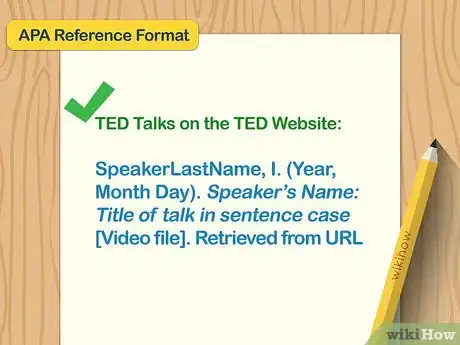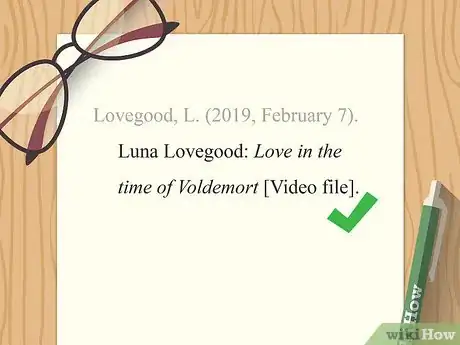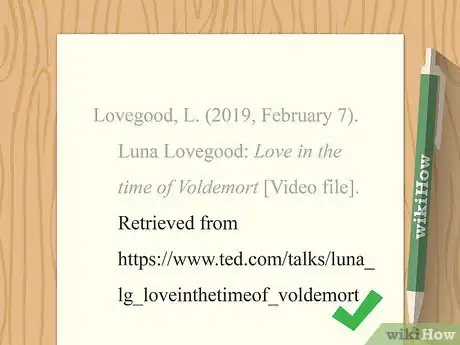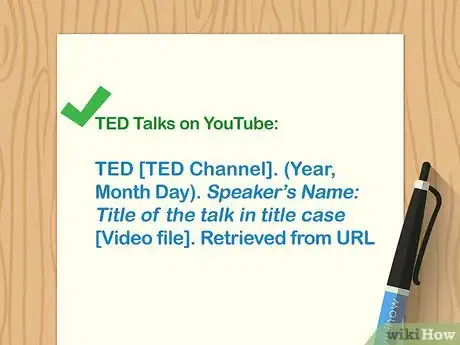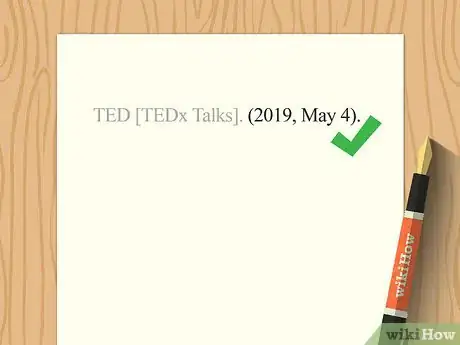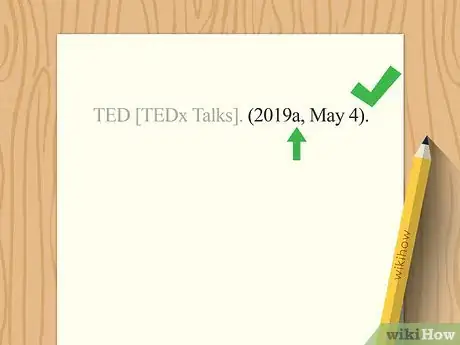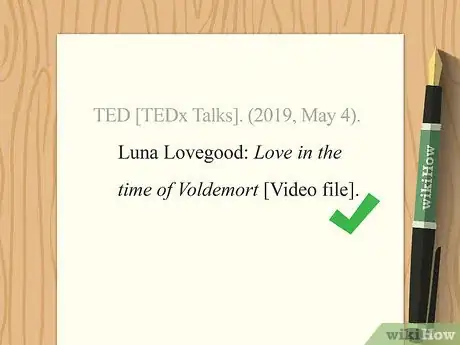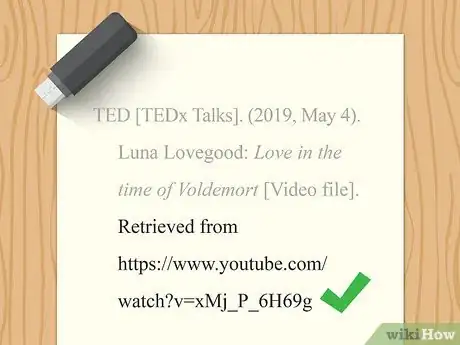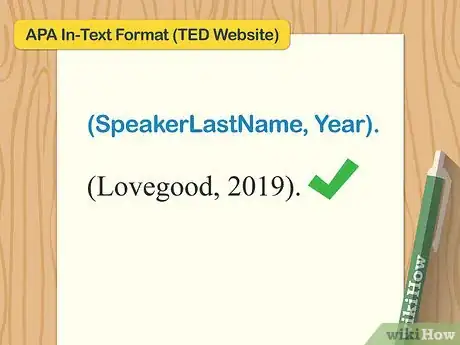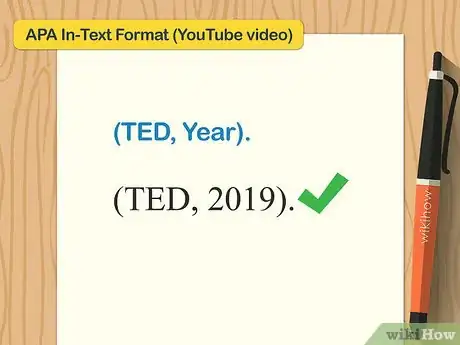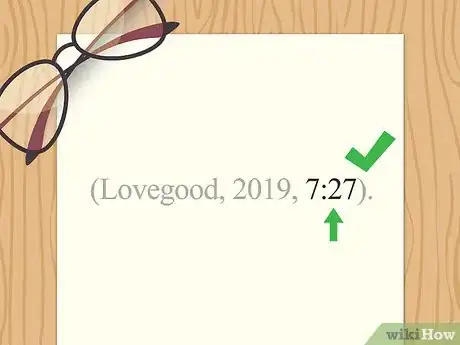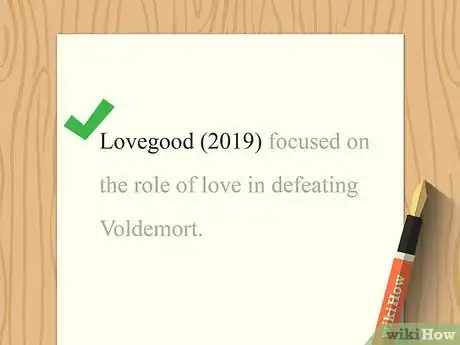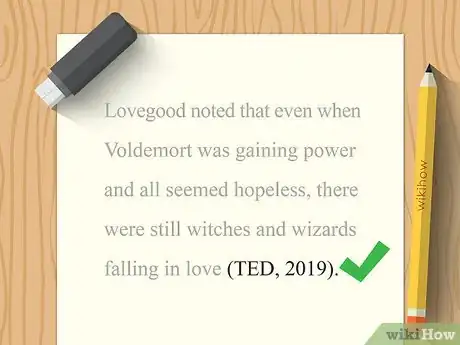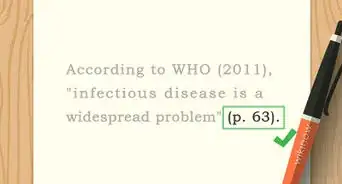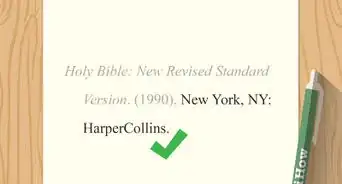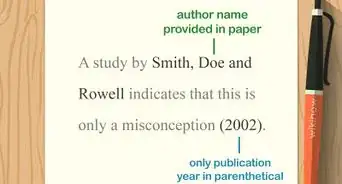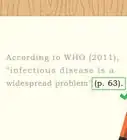This article was co-authored by wikiHow staff writer, Jennifer Mueller, JD. Jennifer Mueller is a wikiHow Content Creator. She specializes in reviewing, fact-checking, and evaluating wikiHow's content to ensure thoroughness and accuracy. Jennifer holds a JD from Indiana University Maurer School of Law in 2006.
This article has been viewed 26,934 times.
Learn more...
Speakers in TED Talks can provide fascinating and compelling new takes on ideas. If you find a TED Talk related to the topic of your research paper, you may want to use the talk as a source. American Psychological Association (APA) citation style requires an in-text citation every time you paraphrase or quote from a TED Talk. That in-text citation points your reader to the correct Reference List entry at the end of your paper. The format for a Reference List entry for a TED talk differs depending on whether you accessed the video on the Ted Talks website or on YouTube.[1]
Steps
Reference List Entry for TED Talks on the TED Website
-
1Start your Reference List entry with the name of the speaker. If you accessed the TED Talk directly from the TED website, the speaker who gave the talk is considered the author of that talk. Type their last name first, followed by a comma, then their first initial.[2]
- Example: Lovegood, L.
-
2Provide the date the video was posted in parentheses. Type the year the video was posted first. If the month (or month and day) the video was posted are provided, type a comma after the year followed by the month and day. Do not abbreviate the name of the month. Place a period outside the closing parenthesis.[3]
- Example: Lovegood, L. (2019, February 7).
Tip: Use the date the video was posted on the TED website, not the date the talk was given, if the two dates are different.
Advertisement -
3List the title of the video and a description of the format. On the TED website, titles are formatted by listing the name of the speaker followed by a colon, then the title of the specific talk. Follow this format in your Reference List entry. Type the title of the specific talk in sentence case, capitalizing only the first word and any proper nouns. Italicize the full title. Add the words "Video file" in square brackets after the title, placing a period outside the closing bracket. Do not italicize this bracketed description.[4]
- Example: Lovegood, L. (2019, February 7). Luna Lovegood: Love in the time of Voldemort [Video file].
-
4Close your entry with a direct URL for the video. Type the words "Retrieved from" followed by the full direct URL or permalink for the video. Do not place a period at the end of the URL (unless the URL itself happens to end with a period).[5]
- Example: Lovegood, L. (2019, February 7). Luna Lovegood: Love in the time of Voldemort [Video file]. Retrieved from https://www.ted.com/talks/luna_lovegood_love_in_the_time_of_voldemort
APA Reference List Format – TED Talks on the TED Website
SpeakerLastName, I. (Year, Month Day). Speaker's Name: Title of talk in sentence case [Video file]. Retrieved from URL
Reference List Entry for TED Talks on YouTube
-
1List TED as the author followed by the name of the channel. If you accessed the TED talk on YouTube, TED is the author. This enables your readers to find the video on YouTube more easily. After the name of the author, include the name of the channel (such as TEDx Talks, TED Institute, or TED Fellows) in brackets. Place a period outside the closing brackets.[6]
- Example: TED [TEDx Talks].
Tip: If you happen to find a TED Talk on YouTube that was posted by another user, try to find the video on one of the TED official channels. A TED Talk video posted by someone else may be edited or altered.
-
2Provide the date the video was posted in parentheses. Start with the year the video was posted, followed by a comma. Then type the month and day the video was posted on YouTube. Note that this date may differ from the date the talk was given or the date the video was uploaded onto the TED website. Do not abbreviate the name of the month, no matter how long it is. Place a period outside the closing parenthesis.[7]
- Example: TED [TEDx Talks]. (2019, February 14).
-
3Distinguish multiple TED Talks by the same author. Since you're using TED as the author for TED Talks you find on YouTube, you typically would distinguish them by date. If they were all posted in different years, you don't have to do anything else – simply order them chronologically in your Reference List with the earliest date first.[8]
- If you're using several TED Talks from YouTube that were all posted in the same year, order them alphabetically by title in your Reference List. Then add a lowercase letter to the end of the year to distinguish them for the purposes of your in-text citations. For example, if you had 3 TED Talks all posted in 2019, you would list them alphabetically by title and then the years would be "2019a," "2019b," and "2019c."
-
4Include the title of the video and the format. TED titles all videos with the name of the speaker followed by a colon, then the title of the specific talk. Follow this format, but type the title of the specific talk in sentence case, capitalizing only the first word and any proper nouns. Italicize the title of the video. Then type the words "Video file" in square brackets to indicate the format. Do not italicize the bracketed information. Place a period outside the closing bracket.[9]
- Example: TED [TEDx Talks]. (2019, February 14). Luna Lovegood: Love in the time of Voldemort [Video file].
-
5Close your entry with a URL for the video. Type a space after the period following the title and format, then type the words "Retrieved from." Include a full URL for the YouTube video to end your Reference List entry. Do not place a period at the end of the URL.[10]
- Example: TED [TEDx Talks]. (2019, February 14). Luna Lovegood: Love in the time of Voldemort [Video file]. Retrieved from https://www.youtube.com/watch?v=xMj_P_6H69g
APA Reference List Format – TED Talks on YouTube
TED [TED Channel]. (Year, Month Day). Speaker's Name: Title of the talk in title case [Video file]. Retrieved from URL
In-Text Citations
-
1Include the name of the speaker and the year the video was posted. If you accessed the TED Talk on the TED website, the last name of the speaker goes in your in-text parenthetical citation. That way your readers will be able to find the full Reference List entry. Place a comma after the last name, then add the year the video was posted. Place the sentence's closing punctuation after the closing parenthesis.[11]
- Example: (Lovegood, 2019).
APA In-Text Citation Format – TED Talks on the TED Website
(SpeakerLastName, Year).
-
2Use "TED" as the author if you accessed the video on YouTube. Since "TED" is the author in your full Reference List entry, use "TED" as the author in your parenthetical citation. Place a comma after "TED," then type the year the video was posted on YouTube. Add the sentence's closing punctuation outside the closing parenthesis.[12]
- Example: (TED, 2019).
APA In-Text Citation Format – TED Talks on YouTube
(TED, Year).
-
3Provide a timestamp for quoted material. If you include a direct quote from the TED Talk in your paper, your parenthetical citation needs to tell your reader exactly where the speaker says those words. Place a comma after the year the video was posted, then add the timestamp. Format your timestamp the same way it is on the source video. For TED Talks either on the TED website or YouTube, it will typically be hours, minutes, and seconds, with each of those elements separated by a colon.[13]
- Example: (Lovegood, 2019, 7:27).
-
4Incorporate citation information into your text to enhance readability. Too many parenthetical in-text citations can be distracting to your readers. However, if you include the same information in your text when it makes sense to do so, you can omit all or part of the parenthetical citation.[14]
- For example, you might write "In her 2019 TED Talk, Lovegood posited that no matter how powerful Voldemort got, he could never harness the power of love." In that instance, if you accessed the TED Talk on the TED website, you wouldn't need any parenthetical citation at all.
- When referencing TED Talks you accessed from the TED website, if you include the speaker's name but not the year in your text, place a parenthetical citation with the year immediately after the speaker's name. For example, you might write "Lovegood (2019) focused on the role of love in defeating Voldemort."
-
5Keep the parenthetical citation for TED Talks from YouTube. If you accessed the TED Talk on YouTube, it typically makes sense for you to include the name of the speaker in the text of your paper. However, doing this does not eliminate the need for a parenthetical citation since the speaker isn't listed as the author.[15]
- For example, you might write "Lovegood noted that even when Voldemort was gaining power and all seemed hopeless, there were still witches and wizards falling in love (TED, 2019)."
- Even if you mention in the text of your paper that the information was presented in a TED Talk, you still probably need a parenthetical citation. Your readers likely wouldn't know to look for an entry that listed "TED" as the author in your Reference List.
Warnings
- Be cautious when using TED talks as a resource for a research paper. While the speakers tend to be verifiable experts in their respective fields, the information they present may not be independently verifiable. Generally, it's best to use TED talks as a resource for subjective thoughts and perceptions, not for objective facts.⧼thumbs_response⧽
References
- ↑ https://blog.apastyle.org/apastyle/2016/02/how-to-cite-a-ted-talk-in-apa-style.html
- ↑ https://blog.apastyle.org/apastyle/2016/02/how-to-cite-a-ted-talk-in-apa-style.html
- ↑ https://blog.apastyle.org/apastyle/2016/02/how-to-cite-a-ted-talk-in-apa-style.html
- ↑ https://blog.apastyle.org/apastyle/2016/02/how-to-cite-a-ted-talk-in-apa-style.html
- ↑ https://blog.apastyle.org/apastyle/2016/02/how-to-cite-a-ted-talk-in-apa-style.html
- ↑ https://blog.apastyle.org/apastyle/2011/10/how-to-create-a-reference-for-a-youtube-video.html
- ↑ https://blog.apastyle.org/apastyle/2011/10/how-to-create-a-reference-for-a-youtube-video.html
- ↑ https://guides.library.lincoln.ac.uk/c.php?g=110736&p=717973
- ↑ https://blog.apastyle.org/apastyle/2011/10/how-to-create-a-reference-for-a-youtube-video.html
- ↑ https://blog.apastyle.org/apastyle/2011/10/how-to-create-a-reference-for-a-youtube-video.html
- ↑ http://writeanswers.royalroads.ca/faq/199138
- ↑ http://writeanswers.royalroads.ca/faq/199138
- ↑ https://blog.apastyle.org/apastyle/2014/01/timestamps-for-audiovisual-materials-in-apa-style.html
- ↑ https://blog.apastyle.org/apastyle/2016/02/how-to-cite-a-ted-talk-in-apa-style.html
- ↑ https://blog.apastyle.org/apastyle/2016/02/how-to-cite-a-ted-talk-in-apa-style.html
